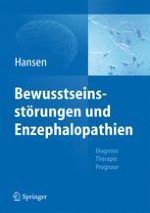2013 | OriginalPaper | Buchkapitel
13. Verlaufsmonitoring von Bewusstseinsstörungen und Enzephalopathien
verfasst von : H.-C. Hansen, W. Haupt, S. Zschocke
Erschienen in: Bewusstseinsstörungen und Enzephalopathien
Verlag: Springer Berlin Heidelberg
2013 | OriginalPaper | Buchkapitel
verfasst von : H.-C. Hansen, W. Haupt, S. Zschocke
Erschienen in: Bewusstseinsstörungen und Enzephalopathien
Verlag: Springer Berlin Heidelberg
Print ISBN: 978-3-642-36914-8
Electronic ISBN: 978-3-642-36915-5
Copyright-Jahr: 2013
